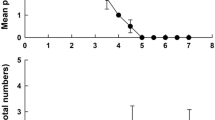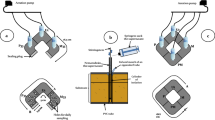Abstract
Larval settlement of the infaunal spionid polychaetes Polydora cornuta and Streblospio benedicti is mediated by sediment-associated microorganisms. To investigate if larval preference for certain sediment is guided by individual sediment-associated bacteria, 13 bacterial isolates (5 phyla) obtained from the natural habitat of adult polychaetes (Wadden Sea, Germany) in 2008 were screened in still-water, no-choice settlement assays. Two isolates (α-Proteobacterium-Strain DF11 and Flavobacterium-Strain 54) significantly triggered larval settlement in comparison with sterile sediment. In still-water, multiple-choice settlement assays comprising natural and sterile sediment and sediment re-inoculated with isolates DF11 and 54, significant preferences for natural sediment and sediment containing bacterial isolates at 108 cells g−1 were observed. Larval settlement was influenced by bacterial abundance in sediment but the correlation was not strictly positive; thus, maximum larval settlement in response to single bacterial species may occur at certain optimum densities. Non-viable or suspended bacteria and water-soluble bacterial products did not induce larval settlement, suggesting that sediment-associated bacterial settlement cues for P. cornuta and S. benedicti were either produced in situ and/or consisted of heat-labile bacterial products.



Similar content being viewed by others
References
Abelson A, Denny M (1997) Settlement of marine organisms in flow. Annu Rev Ecol Syst 28:317–339
Anger K, Anger V, Hagmeier E (1986) Laboratory studies on larval growth of Polydora ligni, Polydora ciliata, and Pygospio elegans (Polychaeta, Spionidae). Helgolander Meeresun 40:377–395
Bachelet G, Butman CA, Webb CM, Starczak VR, Snelgrove PVR (1992) Nonselective settlement of Mercenaria mercenaria (L) larvae in short-term, still-water, laboratory experiments. J Exp Mar Biol Ecol 161:241–280
Blake J (1969) Reproduction and larval development of Polydora from northern New England (Polychaeta: Spionidae). Ophelia 7:1–63
Blake JA, Arnofsky PL (1999) Reproduction and larval development of the spioniform Polychaeta with application to systematics and phylogeny. Hydrobiologia 402:57–106
Buchan A, Gonzalez JM, Moran MA (2005) Overview of the marine Roseobacter lineage. Appl Environ Microbiol 71:5665–5677
Chandler GT, Shipp MR, Donelan TL (1997) Bioaccumulation, growth and larval settlement effects of sediment-associated polynuclear aromatic hydrocarbons on the estuarine polychaete, Streblospio benedicti (Webster). J Exp Mar Biol Ecol 213:95–110
Conover WJ, Iman RL (1980) The rank transformation as a method of discrimination with some examples. Comm Stat Theory Methods 9:465–487
D’Andrea AF, Aller RC, Lopez GR (2002) Organic matter flux and reactivity on a South Carolina sandflat: the impacts of porewater advection and macrobiological structures. Limnol Oceanogr 47:1056–1070
Dorgan KM, Jumars PA, Johnson BD, Boudreau BP (2006) Macrofaunal burrowing: the medium is the message. In: Gibson RN, Atkinson RJA, Gordon JDM (eds) Oceanography and Marine Biology: An Annual Review, vol 44, pp 85–121
Engstrom SJ, Marinelli RL (2005) Recruitment responses of benthic infauna to manipulated sediment geochemical properties in natural flows. J Mar Res 63:407–436
Esser F, Winterberg M, Sebesvari Z, Harder T (2008) Effects of halogenated metabolites from infaunal polychaetes on larval settlement of the spionid polychaete Streblospio benedicti. Mar Ecol Prog Ser 355:161–172
Freitag TE, Klenke T, Krumbein WE, Gerdes G, Prosser JI (2003) Effect of anoxia and high sulphide concentrations on heterotrophic microbial communities in reduced surface sediments (Black Spots) in sandy intertidal flats of the German Wadden Sea. FEMS Microbiol Ecol 44:291–301
Grassle JP, Butman CA, Mills SW (1992) Active habitat selection by Capitella sp I larvae. II. Multiple-choice experiments in still water and flume flows. J Mar Res 50:717–743
Gray JS (1966) The attractive factor of intertidal sands to Protodrilus symbioticus. J Mar Biol Assoc UK 46:627–647
Gray JS (1967) Substrate selection by the archiannelid Protodrilus rubropharyngeus. Helg Wiss Meeresunters 15:253–269
Hadfield MG (2011) Biofilms and marine invertebrate larvae: what bacteria produce that larvae use to choose settlement sites. In: Carlson CA, Giovannoni SJ (eds) Annual Review of Marine Science, vol 3, pp 453–470
Hardege JD, Bentley MG, Snape L (1998) Sediment selection by juvenile Arenicola marina. Mar Ecol Prog Ser 166:187–195
Harder T, Lau SCK, Dahms HU, Qian PY (2002) Isolation of bacterial metabolites as natural inducers for larval settlement in the marine polychaete Hydroides elegans (Haswell). J Chem Ecol 28:2029–2043
Hartmann-Schroeder G (1996) Annelida, Borstenwuermer, Polychaeta. Fischer, Jena
Huang SY, Hadfield MG (2003) Composition and density of bacterial biofilms determine larval settlement of the polychaete Hydroides elegans. Mar Ecol Prog Ser 260:161–172
Huang Y, Callahan S, Hadfield MG (2012) Recruitment in the sea: bacterial genes required for inducing larval settlement in a polychaete worm. Scientific Reports 2
Huggett MJ, Williamson JE, de Nys R, Kjelleberg S, Steinberg PD (2006) Larval settlement of the common Australian sea urchin Heliocidaris erythrogramma in response to bacteria from the surface of coralline algae. Oecologia 149:604–619
Irvine SQ, Martindale MQ (1999) Laboratory culture of the larvae of spionidan polychaetes. Mar Mod Elec Rec [serial online]
Keough MJ, Raimondi PT (1996) Responses of settling invertebrate larvae to bioorganic films: effects of large-scale variation in films. J Exp Mar Biol Ecol 207:59–78
Kirchman DL (2002) The ecology of Cytophaga-Flavobacteria in aquatic environments. FEMS Microbiol Ecol 39:91–100
Kopke B, Wilms R, Engelen B, Cypionka H, Sass H (2005) Microbial diversity in coastal subsurface sediments: a cultivation approach using various electron acceptors and substrate gradients. Appl Environ Microbiol 71:7819–7830
Lam C, Harder T, Qian PY (2005) Induction of larval settlement in the polychaete Hydroides elegans by extracellular polymers of benthic diatoms. Mar Ecol Prog Ser 286:145–154
Lam C, Neumann R, Shin PKS, Au DWT, Qian PY, Wu RSS (2010) Polybrominated diphenylethers (PBDEs) alter larval settlement of marine benthic polychaetes. Environ Sci Technol 44:7130–7137
Lau SCK, Mak KKW, Chen F, Qian PY (2002) Bioactivity of bacterial strains isolated from marine biofilms in Hong Kong waters for the induction of larval settlement in the marine polychaete Hydroides elegans. Mar Ecol Prog Ser 226:301–310
Lau SCK, Harder T, Qian PY (2003) Induction of larval settlement in the serpulid polychaete Hydroides elegans (Haswell): role of bacterial extracellular polymers. Biofouling 19:197–204
Lau SCK, Thiyagarajan V, Cheung SCK, Qian PY (2005) Roles of bacterial community composition in biofilms as a mediator for larval settlement of three marine invertebrates. Aquat Microb Ecol 38:41–51
Levin LA (1984) Multiple patterns of development in Streblospio benedicti Webster (Spionidae) from 3 coasts of North America. Biol Bull 166:494–508
Llobet-Brossa E, Rossello-Mora R, Amann R (1998) Microbial community composition of Wadden Sea sediments as revealed by fluorescence in situ hybridization. Appl Environ Microbiol 64:2691–2696
Maki JS, Rittschof D, Samuelsson MO, Szewzyk U, Yule AB, Kjelleberg S, Costlow JD, Mitchell R (1990) Effect of marine bacteria and their exopolymers on the attachment of barnacle cypris larvae. Bull Mar Sci 46:499–511
Martens T, Gram L, Grossart HP, Kessler D, Muller R, Simon M, Wenzel SC, Brinkhoff T (2007) Bacteria of the Roseobacter clade show potential for secondary metabolite production. Microb Ecol 54:31–42
Matthews TG, Fairweather PG (2006) Recruitment of the infaunal bivalve Soletellina alba (Lamarck, 1818) (Bivalvia : Psammobiidae) in response to different sediment types and water depths within the intermittently open Hopkins River estuary. J Exp Mar Biol Ecol 334:206–218
Mok F, Thiyagarajan V, Qian PY (2008) Larval development and metamorphic behaviour of the subtropical spionid polychaete Pseudopolydora vexillosa. J Exp Mar Biol Ecol 357:99–108
Olivier F, Desroy N, Retiere C (1996) Habitat selection and adult-recruit interactions in Pectinaria koreni (Malmgren) (Annelida: Polychaeta) post-larval populations: results of flume experiments. J Sea Res 36:217–226
Pinedo S, Sarda R, Rey C, Bhaud M (2000) Effect of sediment particle size on recruitment of Owenia fusiformis in the Bay of Blanes (NW Mediterranean Sea): an experimental approach to explain field distribution. Mar Ecol Prog Ser 203:205–213
Qian PY, Thiyagarajan V, Lau SCK, Cheung SCK (2003) Relationship between bacterial community profile in biofilm and attachment of the acorn barnacle Balanus amphitrite. Aquat Microb Ecol 33:225–237
Qian PY, Lau SCK, Dahms HU, Dobretsov S, Harder T (2007) Marine biofilms as mediators of colonization by marine macroorganisms: implications for antifouling and aquaculture. Mar Biotechnol 9:399–410
Radashevsky VI (2005) On adult and larval morphology of Polydora cornuta Bosc, 1802 (Annelida : Spionidae). Zootaxa 1064:1–24
Rossi F, Como S, Corti S, Lardicci C (2001) Seasonal variation of a deposit-feeder assemblage and sedimentary organic matter in a brackish basin mudflat (Western Mediterranean, Italy). Estuar Coast Shelf Sci 53:181–191
Schnurer J, Rosswall T (1982) Fluorescein diacetate hydrolysis as a measure of total microbial activity in soil and litter. Appl Environ Microbiol 43:1256–1261
Sebesvari Z (2007) Sediment-associated cues for larval settlement of Polydora cornuta and Streblospio benedicti (Polychaeta, Spionidae). Dissertation, Institute of Chemistry and Biology of the Marine Environment, Oldenburg
Sebesvari Z, Esser F, Harder T (2006) Sediment-associated cues for larval settlement of the infaunal spionid polychaetes Polydora cornuta and Streblospio benedicti. J Exp Mar Biol Ecol 337:109–120
Snelgrove PVR, Grassle JP, Zimmer CA (2001) Adult macrofauna effects on Capitella sp I larval settlement: a laboratory flume study. J Mar Res 59:657–674
Szewzyk U, Holmstrom C, Wrangstadh M, Samuelsson MO, Maki JS, Kjelleberg S (1991) Relevance of the exopolysaccharide of marine Pseudomonas sp strain S9 for the attachment of Ciona intestinalis larvae. Mar Ecol Prog Ser 75:259–265
Tebben J, Tapiolas DM, Motti CA, Abrego D, Negri AP, Blackall LL, Steinberg PD, Harder T (2011) Induction of larval metamorphosis of the coral Acropora millepora by tetrabromopyrrole isolated from a Pseudoalteromonas bacterium. PLoS ONE 6:e19082
Thiyagarajan V, Soo L, Qian PY (2005) The role of sediment organic matter composition in larval habitat selection by the polychaete Capitella sp I. J Exp Mar Biol Ecol 323:70–83
Thiyagarajan V, Soo L, Shin PKS, Qian PY (2006) Spatio-temporal variation in sediment biochemistry alters larval habitat selection and juvenile performance in the polychaete Capitella sp I. Mar Ecol Prog Ser 327:207–222
Underwood AJ (1997) Experiments in ecology: their logical design and interpretation using analysis of variance. University Press, Cambridge
Valsecchi E (1998) Tissue boiling: a short-cut in DNA extraction for large-scale population screenings. Mol Ecol 7:1243–1245
Van Colen C, Lenoir J, De Backer A, Vanelslander B, Vincx M, Degraer S, Ysebaert T (2009) Settlement of Macoma balthica larvae in response to benthic diatom films. Mar Biol 156:2161–2171
Webster NS, Smith LD, Heyward AJ, Watts JEM, Webb RI, Blackall LL, Negri AP (2004) Metamorphosis of a scleractinian coral in response to microbial biofilms. Appl Environ Microbiol 70:1213–1221
Wieczorek SK, Clare AS, Todd CD (1995) Inhibitory and facilitatory effects of microbial films on settlement of Balanus amphitrite amphitrite larvae. Mar Ecol Prog Ser 119:221–228
Wilson DP (1955) The role of microorganisms in the settlement of Ophelia bicornis Savigny. J Mar Biol Assoc UK 34:531–543
Woodin SA, Marinelli RL, Lincoln DE (1993) Allelochemical inhibition of recruitment in a sedimentary assemblage. J Chem Ecol 19:517–530
Yager PL, Nowell ARM, Jumars PA (1993) Enhanced deposition to pits: a local food source for benthos. J Mar Res 51:209–236
Acknowledgments
We are grateful to PY Qian and co-workers at the Hong Kong University of Science and Technology and D Fischer and R Gahl-Janssen at the University of Oldenburg for assistance in the sequencing of bacterial isolates. This study was supported by a grant of the German Research Foundation to T. Harder (HA 3496/1-2). The authors would like to thank the anonymous reviewers for their valuable comments.
Author information
Authors and Affiliations
Corresponding author
Additional information
Communicated by J. P. Grassle.
Electronic supplementary material
Below is the link to the electronic supplementary material.
Rights and permissions
About this article
Cite this article
Sebesvari, Z., Neumann, R., Brinkhoff, T. et al. Single-species bacteria in sediments induce larval settlement of the infaunal polychaetes Polydora cornuta and Streblospio benedicti . Mar Biol 160, 1259–1270 (2013). https://doi.org/10.1007/s00227-013-2178-8
Received:
Accepted:
Published:
Issue Date:
DOI: https://doi.org/10.1007/s00227-013-2178-8




